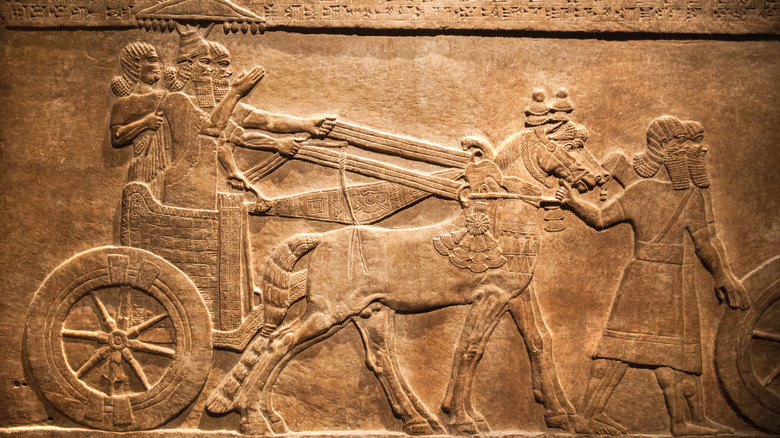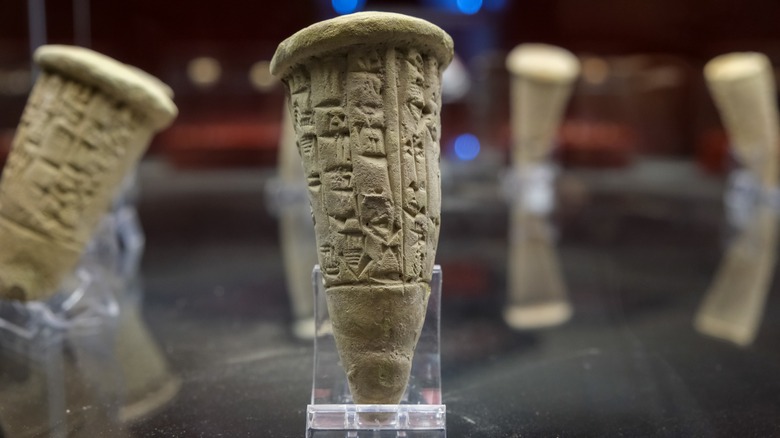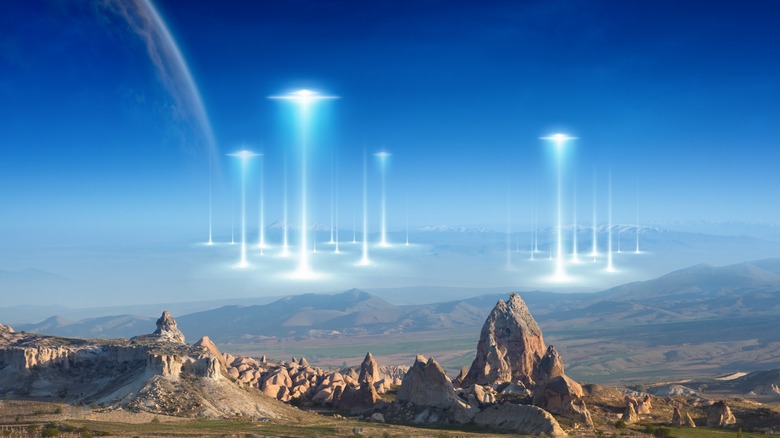How The Gods Of Ancient Civilizations Became Central To Modern Alien Conspiracies
Mention the name "Anunnaki" to alien conspiracy aficionados and you're bound to see eyes light up. "Oh!" the reply might go, "Yeah, those are the alien dudes who genetically manipulated humanity, like, tens of thousands of years ago or whatever to be slaves and were worshipped in ancient Mesopotamia as gods!" "Say what?" you might reply. Take that smorgasbord of accreted notions, top it with something-something Reptilian Illuminati Area-51 Zeta Reticulin UFO government cover-up, etc., etc., add a dash of galactic federations, talk of humanity's "ultimate destiny" and such, and bam: You've got the recipe for an episode of the History Channel's gloriously much-memed "Ancient Aliens" show.
So let's back up a bit. Yes, some folks believe that gods mentioned in ancient mythologies — at least some of them — were extraterrestrials, including the Mesopotamian Anunnaki. This Ancient Astronaut (AA) "Theory," as it's erroneously called (hint: it's not a theory), came into popular discussion in the 1970s. So the astonishing Pyramids at Giza, as AA claims? No way dumb-dumb humans could have built them — it was aliens. Mythological figures like the civilizing Mesoamerican god Quetzalcoatl? Nah, he was an alien. The dinosaurs? Aliens pew-pewed them to death because they needed to pave the way for hairless apes, as Riley Black ruthlessly mocks in Smithsonian Magazine. The Anunnaki got roped into AA lore through one influential 20th-century sci-fi-like writer with a decent imagination: Zecharia Sitchin.
10,000 years of world-building
The trail from Mesopotamian religion circa 7,000 years ago to modern Reddit slurry is long and twisted. Central to the tale is Mesopotamia itself, a term used not to denote a specific civilization or people, but a geographic area roughly equivalent to modern-day Iraq between the Tigris and Euphrates Rivers, aka the "Cradle of Civilization."
Mesopotamia was home to one subsequent, overlapping, and competing civilization after another: Sumerian, Akkadian, Amorite, Assyrian, Babylonian, Hittite, and many more all the way from 10,000 B.C.E. to the Roman annexation of Judea from 63 to 313 C.E. Such a colossal timeframe encompasses a staggering amount of cultures, beliefs, traditions, religious practices, and more. But out of this entire period, ancient Sumer gets the most attention for being the first civilization to invent lots of things for the first time: cities, writing, record-keeping, bricks, board games, beer, sailing, cartography, our 24-hour, 60-minute, 60-second clock, and more.
The reign of the Sumerian king Gudea (2144 to 2124 B.C.E.) sees the first mention of the Anunnaki in text. Similar to the Norse Aesir (Odin, Thor, Tyr, etc.), Egyptian Ogdoad (Kuk, Amun, Nun, etc.), and Greek Olympians (Zeus, Hera, Aphrodite, etc.), the Anunnaki were a pantheon, or caste, of gods. They were responsible for the creation of the world, its order and maintenance, and fought amongst themselves in a familial, dynastic fashion. They also fashioned humans to be their laborers.
Created in service of the gods
The textual tie between the Anunnaki and modern Ancient Astronaut Theory comes from specific plot points within Sumerian creation stories. These stories describe the fashioning of the world, humanity's place within it, and humanity's relationship with the gods. The earliest gods were An (heaven) and Ki (earth), whose names put together form "Anunnaki," and whose mother was the primordial waters Nammu. Different creation stories come from different points in Mesopotamian history and contain variations, but all of them concur that humans were made to serve the gods and maintain earthly order on their behalf.
The story "Enki and Ninmah" describes the creation of humans, starting with Nammu. Like a tired mother, she complains to her son and the god of wisdom, Enki, about how exhausting it is tending to her creation. She begs Enki to "create a substitute for the gods so that they can be freed from their toil." After sculpting clay into a bunch of failed attempts — including a human with weak hands, a man who couldn't stop peeing, and a person with no genitals — Enki and his sister Nimhah hit the jackpot. Afterward, "The Song of the Hoe" describes how Enlil, god of air, made a space for humanity by separating Earth and sky with a giant farming hoe. Things like food and water for humans came later.
Long-silent voices of the past
The stories of the Anunnaki sat untouched for a couple thousand years. Ancient Rome (about 509 B.C.E. to 476 C.E.), which dominated Europe, Northern Africa, Asia Minor, and the Levant, revered Greek civilization, not any of the Mesopotamian civilizations. Christian medieval scholars (about 476 C.E. to 1300 C.E.) did the same, and so did those living through the Renaissance (about 14th to 17th centuries) and the Enlightenment (about late 1600s to early 1800s). And while curiosity about ancient Greece — and by extension Rome — never died down that entire time, the gods of Sumer, Assyria, and Babylon remained all but lost.
Archaeology, as a discipline, didn't even begin to touch Mesopotamia until the discovery of the cities of Assur and Babylonia less than 200 years ago. Even today, tens of thousands of Mesopotamian clay tablets remain untranslated, many written in Akkadian, the international lingua franca of Mesopotamia for almost 2,000 years from 1,900 B.C.E. to 75 C.E. As The Times of Israel explains, modern researchers are using AI to help them translate these ancient texts. And because studies into ancient Mesopotamia came late in the game, it was easier for researchers, writers, etc., to approach Mesopotamian stories with a greater degree of flexibility. It would seem ludicrous to say, "Zeus was real and he was an alien," for instance. But Enki? This seems more plausible simply because a figure like Enki is less familiar, more remote, and more, so to speak, alien.
The follies of Zecharia Sitchin
The lynchpins transforming long-silent Mesopotamian mythology into pervasive, modern-day Ancient Astronaut (AA) Theory were the fancies, imagination, and spurious "translations" of a single person: Zecharia Sitchin (1920 to 2010). Sitchin was an Azerbaijan-born, London-educated writer who took an interest in Mesopotamian history and, as Ohio State University recounts, once claimed to be "one of few scholars able to read and interpret ancient Sumerian and Akkadian clay tablets." According to historian Jason Jarrel on Ancient Origins, Sitchin's conclusions range from "mistranslations" to "completely fabricated." They can be summarized thusly: The Anunnaki were aliens who crossed their DNA with humans to create an enslaved gold-digging race before heading back to their secret planet, Nibiru, which is in a 3,600-year orbit around the sun.
Sitchin didn't just write one or two articles about his ideas, but an entire, seven-book "Earth Chronicles" series starting with "The 12th Planet" in 1976. Sitchin was a prolific writer, in fact, as sites like Paperback Swap show, who released sci-fi-like outings all the way to 2010, the final year of his life. His books were wildly popular, sold millions, and went on to inspire other concurrent and later researchers. In a late-life interview with Sitchin in The New York Times — which describes the author as an unassuming, "distinguished old man" shuffling around with a cane — he said, "You could start by calling me the most controversial 89-year-old man in New York. Or you could just say I write books."
A wildfire of alien notions
Zecharia Sitchin wasn't alone in his assertions. In fact, he rode the wave of Ancient Astronaut (AA) Theory germinated by Swiss-born writer Erich von Däniken in his 1968 book, "Chariots of the Gods." Von Däniken — a "forefather" of AA Theory, as publisher Simon & Schuster puts it — is still alive and active in UFO-alien circles, and is a regular guest on the History Channel's "Ancient Aliens." But while von Däniken's "Chariots of the Gods" is the quintessential "ancient gods were aliens" book, it's Sitchin who first linked AA Theory to the Mesopotamian Anunnaki pantheon of gods.
Since then, the idea of the Anunnaki as humanity's genetic tinkerers has only spread from kindling to full-blown conflagration. The paranormal-mystical entertainment site Gaia delves into the Anunnaki quite a bit, while writers like Chris Hardy in "DNA of the Gods" have taken the story many steps further and connected it to the biblical Adam and Eve tale and semi-apocryphal stories of Nephilim giants. "Slave Species of the Gods" by Michael Tellinger connects the tale to every major religion in the history of humanity, while "Anunnaki: Reptilians in the History of Humankind" connects the Anunnaki to current reptilian conspiracies.
In the end, we can say two things for sure: 1) The AA-Annunaki connection is here to stay, and 2) The fascination with the "humanity is a moronic slave race doomed to fruitless labor in service of higher powers" story speaks volumes about no one else but us.





